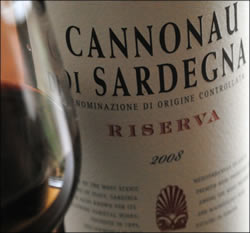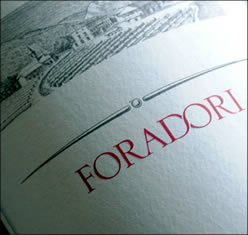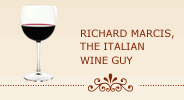Two Great Red Wines from Disparate Regions in Italy
Wine for march - Under $20
Sella and Mosca, Cannonau di Sardegna Riserva 2008 (about $14)
Cannonau is the most widely-planted variety on the island of Sardegna (Sardinia) which is located off mainland Italy’s southwesern coast. Cannonau is ideally suited to the island’s hot and dry Mediterranean climate.
It is not entirely clear exactly where the grape is from but it is believed to have originated in Sardinia. Nonethless, once it found a home and took root in Sardinia it then spread to Spain, where it is called Garnacha, and France and eventually to the U.S., Australia and other parts of the world where it generally is known as Grenache. It produces well structured, deeply-colored, aromatic wines with dark fruit flavors. A wood-aged Cannonau can be powerful and long-lived with black-cherry fruit flavors that make it an ideal food companion to Sardinia’s rich pasta and traditional roasted pork and lamb dishes.
 Located in the northwest corner of Sardinia not far from the popular coastal resort of Alghero, the 1,600 acre Sella and Mosca estate is Sardinia’s largest and most prominent winery. Founded by two professional colleagues from northern Italy at the turn of the previous century, the Sella and Mosca winery is one Italy’s - and Europe’s - largest wine estates. The winery produces a small lineup of wines made primarily of native varieties such as Cannonau, Carignano, Torbato and Vermentino but also includes a few international favorites such as Cabernet Sauvignon.
Located in the northwest corner of Sardinia not far from the popular coastal resort of Alghero, the 1,600 acre Sella and Mosca estate is Sardinia’s largest and most prominent winery. Founded by two professional colleagues from northern Italy at the turn of the previous century, the Sella and Mosca winery is one Italy’s - and Europe’s - largest wine estates. The winery produces a small lineup of wines made primarily of native varieties such as Cannonau, Carignano, Torbato and Vermentino but also includes a few international favorites such as Cabernet Sauvignon.
The estate’s Cannonau de Sardegna Riserva is made entirely of Cannonau grapes harvested in late autumn. The grapes are vinified in stainless steel tanks for two weeks. After fermentation the wine is aged in large oak casks for two years and then spends a few months in the bottle prior to release for sale.
The 2008 Cannonau di Sardegna Riserva by Sella and Mosca is an intriguing wine that impresses with its intense richness and depth of dark fruit flavors. It is full-bodied with good acidity and rich, ripe, plummy flavors backed by firm tannins. It is a delicious and unpretentious wine with a slight rustic edge evocative of its warm Mediterranean heritage. It is the ideal wine to accompany pasta dishes with meat-based sauces, braised meats or porcini mushroom risotto.
When cellared properly, wood-aged Cannonau riserva wines such as this can age gracefully for another decade or more.
Wine for march – over $20
Foradori, Teroldego Vigneti delle Dolomiti IGT 2011 (about $25)
In contrast to Sardinia’s hot and dry Mediterranean climate, this charming and vivacious red wine comes from the Trentino valley in the shadows of the Dolomiti Mountains in the far reaches of Italy’s northern-most region. While this is first and foremost white wine country with Pinot Grigio, Müller Thurgau and Chardonnay playing prominent roles, nonetheless some really great - but not especially well known - red wines are produced here.
Teroldego (tare ol day’ go) is an ancient and obscure red grape variety that is virtually unknown outside of Italy - but that may change soon. Genetically related to Syrah, Teroldego produces deeply-colored wines with intense and fruity flavor profiles.
The grape is grown only in a relatively small area of the Trentino valley called the Campo Rotaliano which was officially recognized in 1971 as the Teroldego Rotaliano DOC. The Teroldego grape flourishes here in the valleys surrounded by the Dolomiti Mountains that provide protection for the grapes from extreme heat or cold. The grape doesn’t travel well as it is not seen elsewhere in Italy or anyplace else in the world for that matter. While Teroldego wines have been produced here for years the variety has languished in obscurity as the wines were carelessly made by producers that basically emphasized quantity over quality and were consumed locally.
This is where Elisabetta Foradori enters the picture. She has been in charge of her small, family-run Foradori winery for over 20 years and during this time has worked hard to change the substance and image of Teroldego wines. Whereas most producers carelessly planted Teroldego anywhere they could space, Elisabetta carefully planted Teroldego in only the best vineyard locations. She showed that when grown in the prime locations with low yields and proper vineyard management as well as a good measure of inspired winemaking, the Teroldego grape is capable of producing world-class wines of character and complexity.
As the quality of Foradori’s wines improved they began to catch the attention of wine enthusiasts throughout Italy and her wines began appearing on the wine lists of some of Italy’s best restaurants. In the process of bringing the world’s attention to this previously obscure but ancient variety she joined the ranks of a small but growing number of female wine producers that have achieved the equivalent of rock-star status in Italy’s vibrant wine scene.
ancient variety she joined the ranks of a small but growing number of female wine producers that have achieved the equivalent of rock-star status in Italy’s vibrant wine scene.
Foradori produces several different Teroldego wines. The estate’s top-of-the-line Teroldego is labeled “Granato.” It is an outstanding wine made entirely of Teroldego grapes hand selected from the estate’s best vineyards. It is celebrated as one of Italy’s best wines and is a serial recipient of Gambero Rosso’s prestigious Tre Bicchieri award.
The estate’s simply labeled “Teroldego Vigneti delle Dolomiti” is its entry-level Terodelgo wine. It is made entirely from Terodelgo grapes harvested from several of the estate’s vineyards. The wine is fermented in stainless steel tanks after which it spends a year ageing in oak casks and a few months in the bottle prior to release for sale.
The 2011 Foradori Teroldego has a distinctive fruity profile with soft tannins. While it has a hardy Syrah-like aspect to its character it’s a wine that seduces you with its appealing texture and complexity rather than power. It is nicely balanced, structured, and delicious from beginning to end. The wine requires some time to achieve its footing so it should be opened and decanted at least 2 hours before serving. While the wine is ready to drink now it will age well for up to 10 years.
For those not familiar with Teroldego wines - which probably include most of us - this is a great introduction to the variety. You may find yourself returning to the wine shop for more or possibly cranking it up a notch and splurging on Foradori’s upscale Granato wine.
©Richard Marcis
March 6, 2014
To view other wine of the month selections, see Monthly Wine Reviews


